When it comes to buying a new desktop computer for your small business, the good news is that, as always, PC prices continue to fall and performance continues to rise. But the evolving desktop also comes with new technologies, specifications, assorted gizmos and confusing marketing lingo — which explains why shopping for a new small-business PC can feel like visiting a foreign country whose native language changes every eighteen months.
In this article, we’ll decipher the latest PC buzzwords splashed across marketing literature and consider which ones may or may not be most valuable to your business.
 |
| Lenovo 3000J Series Desktop |
Processors On Parade
Major shifts in CPU technology have taken place in the past year. The latest and greatest is the introduction of dual-core processors. These effectively squeeze two processing units into one physical chip. While it used to be only servers that featured multiple CPUs, dual-core processors now bring multi-processing capabilities to the desktop.
Both Intel and AMD are aggressively marketing dual-core CPUs for the desktop. Intel introduced its dual-core desktop solution with the Pentium D models and is now pushing the newer Core 2 Duo. AMD sells its dual-core desktop processor under the name Athlon 64 X2.
Dual-core processors provide the most benefit to desktops that are used to multitask, or run several applications at the same time. But because they also benefit from newer architecture overall, the latest dual-core processors tend to also consume less power and generate less heat than even their single-core predecessors. That’s good news for the environment and for your bottom line — think smaller electric bills.
Intel’s Core 2 Duo, in particular, is considered by many the best performing dual-core desktop processor now available.
Forward-looking PC buyers should choose a desktop PC with a dual-core processor. Both the Athlon 64 X2 and Core 2 Duo are strong choices. Avoid the older, inefficient Pentium D dual-core processor, which you will still find in many vendor’s desktop PC inventories. Don’t be fooled by Megahertz speeds alone. Older Pentiums (including the D and the 4 models) may advertise higher clock speeds than the Core 2 Duo, but actually perform real tasks more slowly.
For the small business owners looking for performance on a budget, consider an AMD-based single-core solution like the Athlon 64. In comparison, the inefficient and power-hungry single-core Pentium 4 line just doesn’t stack up. Take a pass on ultra-low-cost desktops using the AMD Sempron or Intel Celeron processors — technology best left to low-end home computers.
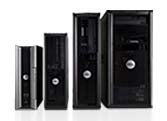 |
| Dell OptiPlex 745 |
Good Memory
Just about every small business desktop available uses DDR2 SDRAM. The DDR2 memory is available in a variety of speeds, which varies from model to model.
DDR2 memory speeds range from 400 Mhz to 1,000 Mhz. Most of today’s small business desktops use 533, 667, or 800 Mhz memory. While the latter is of course fastest, the real-world difference is not significant enough to strongly influence a purchasing decision.
The amount and expandability of the memory is more important than the actual speed. Many small business desktop configurations start with a minimum of 512MB of memory. For a light workload this may do, but a well-equipped desktop should be outfitted with at least one gigabyte (GB). Many can accommodate a maximum of 4GB.
Whether you can easily add memory later depends on how many internal slots the desktop has and how many are already in use. Most models feature either two or four memory slots, some or all of which will be occupied with the memory you choose at purchase.
Newer “dual channel” DDR2 memory offers improved performance but occupies more of your available memory slots, since its modules must be installed in pairs.
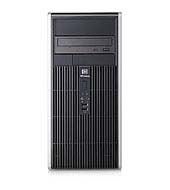 |
| HP Compaq dc5750 Business PC |
Smart Storage
The latest buzzword in disk storage technology is SATA, or Serial ATA. SATA drives transfer data from the disk to memory faster than earlier hard drives. Actual transfer speeds vary quite a bit and generally do not come close to the advertised SATA speeds, which are theoretical maximums. Regardless, SATA drives come with most small-business desktops.
Hard drives also vary in rotation speed. Faster rotation, measured in revolutions per minute (RPM), improves the throughput and responsiveness of the drive. Most small-business desktop drives feature 7,200RPM. Stay away from low-end disks rated at 5,400RPM, although few should show up in business-oriented PCs. For high-performance applications like high-definition video editing, consider a 10,000RPM drive, the fastest single-drive solutions you’ll find in business desktops.
Of course, hard drives also vary in capacity. These days, 80GB is about as small as you’ll find at the low end. 160GB is more common, although most small-business desktop vendors offer a range of drive capacities. You may even have the choice of 250GB or larger drives.
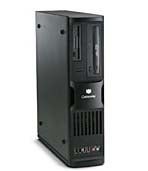 |
| Gateway E-4610S SB |
Expandability also varies. Smaller desktop cases may accommodate two hard drives, while larger systems can accommodate as many as four. However, with many external hard drives now on the market both in USB and networked versions, limited internal storage expansion is not necessarily a significant limitation.
High-end small-business desktops include a more advanced storage technology known as RAID, or “Redundant Array of Independent Disks.” A RAID array combines two or more hard drives. RAID arrays can enhance performance, data protection and integrity, or both. A RAID array configured for maximum performance distributes data across all of the hard drives.
Unfortunately, if one drive goes bad, you lose all your data. Conversely, a RAID array configured for maximum data protection mirrors data between drives. In this case, if one drive fails, the other contains a complete, up-to-date backup.
Not many small businesses need the speed advantage offered by a RAID array, but data backup is another story. In mirroring mode, a RAID array can be invaluable for protecting business-critical applications.
Networking and Graphics
Many desktop PCs now feature gigabit Ethernet, which is up to ten times faster than “common” (100Mbps) Ethernet when used in a gigabit-capable network. Indeed, to get the most out of a gigabit Ethernet connection you need both a gigabit-capable switch and other gigabit-capable PCs in your local network.
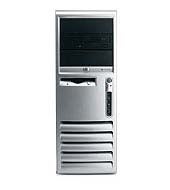 |
| HP Compaq dc7700 Business PC |
Every small business desktop PC includes video capabilities adequate for typical productivity applications with a single display. Do you need multiple displays? Increasingly, some people prefer dividing applications across two monitors. You may need to budget for a video card upgrade to support multiple monitors, or handle graphics-intensive tasks like high-definition video editing, CAD or other 3D modeling applications.
Windows XP and Vista
Most small businesses rely on Windows XP. Many PC vendors offer it in both Home and Professional versions, but the Home edition is often too limited for small business environments. It lacks remote desktop capability, automated system recovery (ASR), and Active Directory domain membership and Group Policy support, among others.
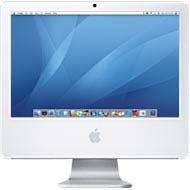 |
| Apple iMac |
Windows Vista, the successor to Windows XP, is scheduled for release in early 2007. There is much confusion among buyers about support for Vista in the latest desktop PCs.
Technically, Windows Vista requires at least 512MB of memory and a 1Ghz or faster CPU. Every small business desktop will meet or exceed these minimums. “Aero,” Vista’s new and much-hyped desktop interface supports advanced visual effects such as translucent “glass” windows.
The basic graphics capabilities built into some small-business desktops will not support the full Aero feature set, which simply means that Vista will display a conventional, Windows XP-style desktop. These systems are marketed as “Windows Vista Capable.”
A desktop PC with enhanced video that fully supports the Aero interface will be marketed as “Windows Vista Premium Ready.” In many cases the vendor can recommend an available video card to upgrade a “Capable” PC to “Premium Ready.”
System Samples
Prices and models change frequently, but these small-business desktop systems represent what major vendors have to offer (at least what was available at press time). These systems can be configured to a range of performance levels. Note that the base price listed does not necessarily reflect our recommended processor configuration.
| Small Business Desktops: Sample Configs and Pricing | |||||
| Vendor Model | Recommended Processor | Memory | Hard Drive | Other | Base Price |
| Lenovo 3000J | Athlon 64 X2 | DDR2 533 Mhz 2 slots, max 2GB | 160GB SATA (7,200 RPM) | N/A | $599 |
| Dell OptiPlex 745 | Intel Core 2 Duo | DDR2 533, 667 or 800 Mhz, 4 slots max 4GB | 80-250GB SATA (7,200 RPM) RAID support | Dell Remote management | $774 |
| HP Compaq dc5750 | AMD Athlon 64 (single-core) or Athlon 64 X2 (dual-core) | DDR2 667 Mhz, 4 slots, max 4GB | 80/160/250GB SATA (7,200 RPM) RAID support for data protection | Remote management with HP tools | $813 |
| Gateway E-4610S SB | Intel Core 2 Duo | DDR2 667 Mhz, 512MB, 4 slots, max 2GB | 80/160/250GB SATA (7,200 RPM) | Intel vPro remote management and security | $1,079 |
| HP Compaq dc7700 | Intel Core 2 Duo | DDR2 667 or 800 Mhz, 4 slots, max 4GB | 80-250GB SATA (7,200 RPM) RAID support for dual drives | Intel vPro remote management and security | $1,199 |
| Apple iMac | Intel Core 2 Duo | 512MB DDR2 667 built-in, plus 2 SO-DIMM slots supporting 2-3GB | 160/250/500GB SATA (7,200 RPM) | Unique form factor built into a 17 inch display | $1,199 |
What About the Mac?
With some reports indicating that the Mac market has increased by over 20 percent in the past year, small businesses in particular may be more interested than ever in what Apple has to offer.
The Macintosh has undergone fundamental architectural changes in the past few years, first with the introduction of its OS X operating system and lately with Apple’s switch to an Intel-based platform. Now that the inner hardware of the Mac is basically identical to a PC, Apple can offer faster machines at more competitive prices than in the past.
People who prefer the Mac praise its consistent, intuitive interface, reliability and general lack of virus and spyware woes that can plague Windows PCs. Integrating Macs into a Windows network is easy, including sharing Web documents, files and printers.
You’ll find Mac software compatible with most popular productivity applications including Microsoft Office, Outlook and Adobe Photoshop. Specialized business applications may only be available for Windows. Also note that the new Apple Macintoshes can run Windows XP alongside OS X, providing full compatibility with both platforms.
Apple sells two desktop systems, the iMac and the Mac Pro. The Pro offers more computer than most small businesses need for a desktop, with four processing cores and a starting price over $2,000.
The iMac is the Apple desktop more comparable to the small-business PC desktops described here. Its best-value configuration is currently priced at $1,199, which includes the new Core 2 Duo CPU, 1GB of memory, a 160GB SATA hard drive, high-performance ATI x1600 video and a 17-inch, flat-panel monitor. In fact, the computer is built right into the monitor — there is no separate case at all.
Aaron Weiss a technology writer, screenwriter and Web development consultant who spends his free time stacking wood for the winter in Upstate New York. His Web site is: bordella.com
Do you have a comment or question about this article or other small business topics in general? Speak out in the SmallBusinessComputing.com Forums. Join the discussion today!

